Business Law: UK Classifications, Sources, and Employment Impact
VerifiedAdded on 2023/06/08
|7
|2029
|434
Homework Assignment
AI Summary
This assignment solution addresses key aspects of UK business law, covering three main questions. The first question explores the classifications of UK laws, including national and international legislation, and identifies the jurisdictional powers of courts. The second question delves into the sources of law within the English legal system, such as international conventions, treaties, and precedents, while also evaluating their importance and impact. Furthermore, it examines how multilingual organizations affect the UK legal system. The final question analyzes the impact of employment law on commercial organizations, including relevant legislation like the Equality Act 2010 and the Employment Rights Act 1996, and outlines the duties employers must fulfill to protect employees.
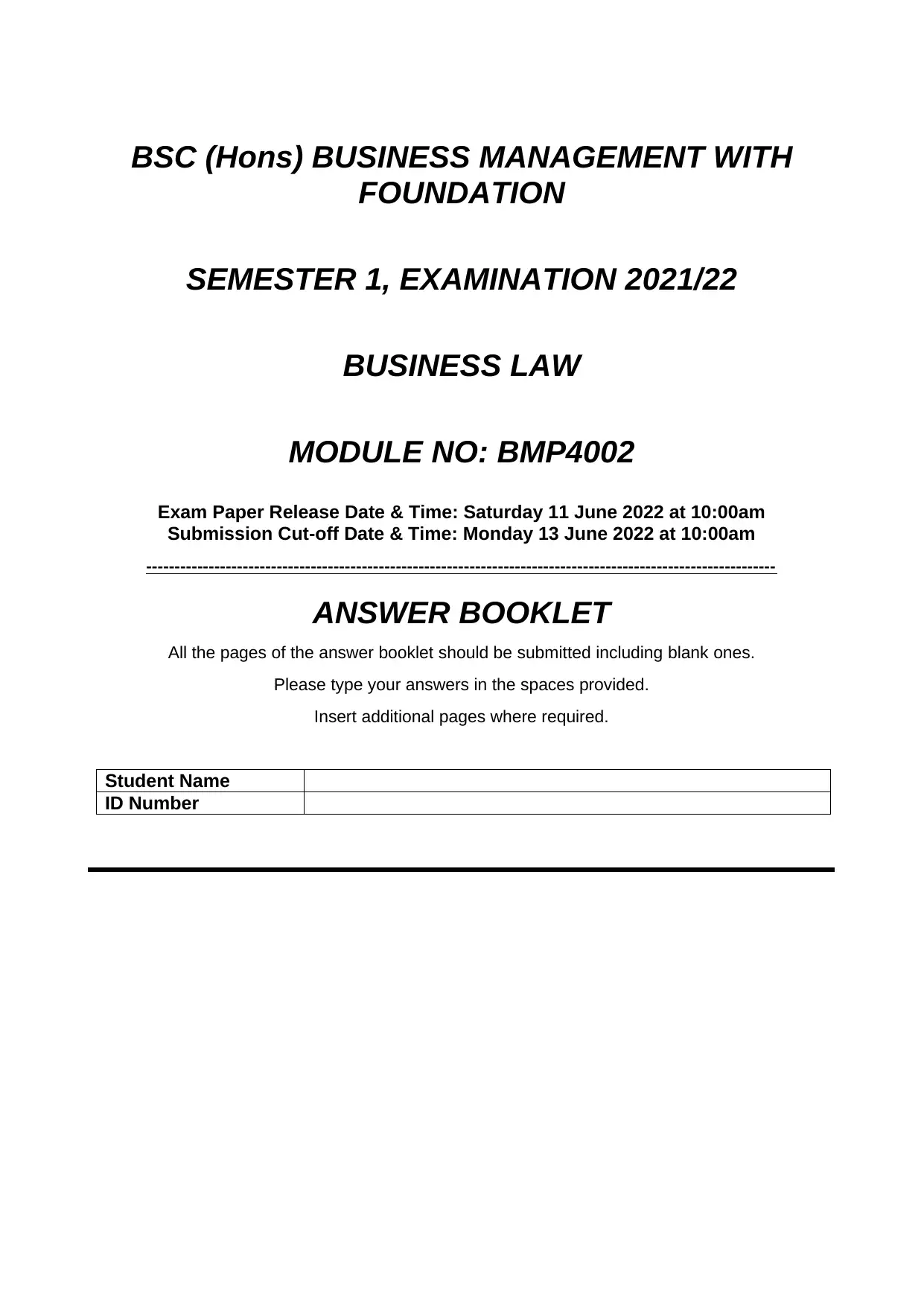
BSC (Hons) BUSINESS MANAGEMENT WITH
FOUNDATION
SEMESTER 1, EXAMINATION 2021/22
BUSINESS LAW
MODULE NO: BMP4002
Exam Paper Release Date & Time: Saturday 11 June 2022 at 10:00am
Submission Cut-off Date & Time: Monday 13 June 2022 at 10:00am
---------------------------------------------------------------------------------------------------------------
ANSWER BOOKLET
All the pages of the answer booklet should be submitted including blank ones.
Please type your answers in the spaces provided.
Insert additional pages where required.
Student Name
ID Number
FOUNDATION
SEMESTER 1, EXAMINATION 2021/22
BUSINESS LAW
MODULE NO: BMP4002
Exam Paper Release Date & Time: Saturday 11 June 2022 at 10:00am
Submission Cut-off Date & Time: Monday 13 June 2022 at 10:00am
---------------------------------------------------------------------------------------------------------------
ANSWER BOOKLET
All the pages of the answer booklet should be submitted including blank ones.
Please type your answers in the spaces provided.
Insert additional pages where required.
Student Name
ID Number
Paraphrase This Document
Need a fresh take? Get an instant paraphrase of this document with our AI Paraphraser

2 of 7
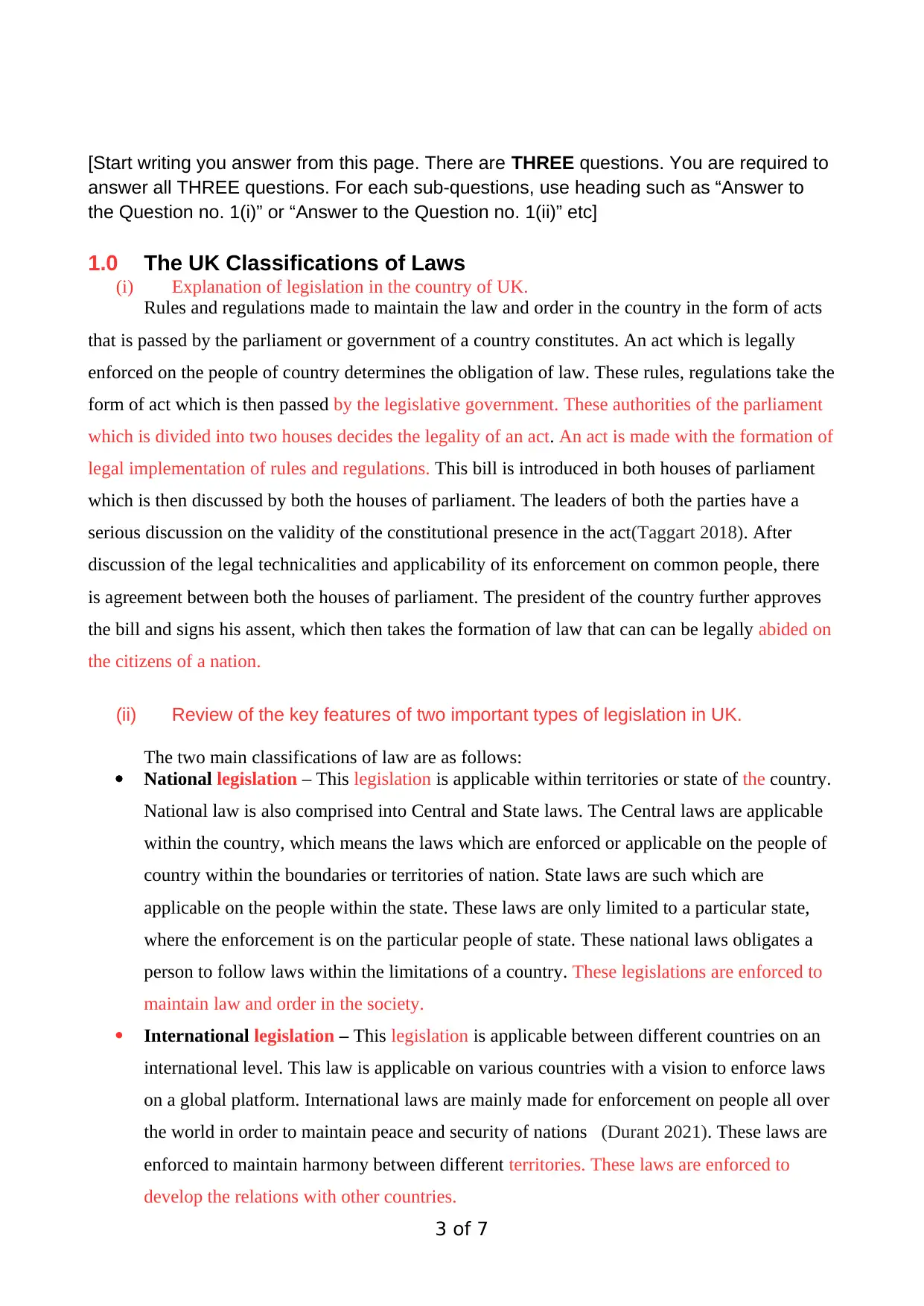
[Start writing you answer from this page. There are THREE questions. You are required to
answer all THREE questions. For each sub-questions, use heading such as “Answer to
the Question no. 1(i)” or “Answer to the Question no. 1(ii)” etc]
1.0 The UK Classifications of Laws
(i) Explanation of legislation in the country of UK.
Rules and regulations made to maintain the law and order in the country in the form of acts
that is passed by the parliament or government of a country constitutes. An act which is legally
enforced on the people of country determines the obligation of law. These rules, regulations take the
form of act which is then passed by the legislative government. These authorities of the parliament
which is divided into two houses decides the legality of an act. An act is made with the formation of
legal implementation of rules and regulations. This bill is introduced in both houses of parliament
which is then discussed by both the houses of parliament. The leaders of both the parties have a
serious discussion on the validity of the constitutional presence in the act(Taggart 2018). After
discussion of the legal technicalities and applicability of its enforcement on common people, there
is agreement between both the houses of parliament. The president of the country further approves
the bill and signs his assent, which then takes the formation of law that can can be legally abided on
the citizens of a nation.
(ii) Review of the key features of two important types of legislation in UK.
The two main classifications of law are as follows:
National legislation – This legislation is applicable within territories or state of the country.
National law is also comprised into Central and State laws. The Central laws are applicable
within the country, which means the laws which are enforced or applicable on the people of
country within the boundaries or territories of nation. State laws are such which are
applicable on the people within the state. These laws are only limited to a particular state,
where the enforcement is on the particular people of state. These national laws obligates a
person to follow laws within the limitations of a country. These legislations are enforced to
maintain law and order in the society.
International legislation – This legislation is applicable between different countries on an
international level. This law is applicable on various countries with a vision to enforce laws
on a global platform. International laws are mainly made for enforcement on people all over
the world in order to maintain peace and security of nations (Durant 2021). These laws are
enforced to maintain harmony between different territories. These laws are enforced to
develop the relations with other countries.
3 of 7
answer all THREE questions. For each sub-questions, use heading such as “Answer to
the Question no. 1(i)” or “Answer to the Question no. 1(ii)” etc]
1.0 The UK Classifications of Laws
(i) Explanation of legislation in the country of UK.
Rules and regulations made to maintain the law and order in the country in the form of acts
that is passed by the parliament or government of a country constitutes. An act which is legally
enforced on the people of country determines the obligation of law. These rules, regulations take the
form of act which is then passed by the legislative government. These authorities of the parliament
which is divided into two houses decides the legality of an act. An act is made with the formation of
legal implementation of rules and regulations. This bill is introduced in both houses of parliament
which is then discussed by both the houses of parliament. The leaders of both the parties have a
serious discussion on the validity of the constitutional presence in the act(Taggart 2018). After
discussion of the legal technicalities and applicability of its enforcement on common people, there
is agreement between both the houses of parliament. The president of the country further approves
the bill and signs his assent, which then takes the formation of law that can can be legally abided on
the citizens of a nation.
(ii) Review of the key features of two important types of legislation in UK.
The two main classifications of law are as follows:
National legislation – This legislation is applicable within territories or state of the country.
National law is also comprised into Central and State laws. The Central laws are applicable
within the country, which means the laws which are enforced or applicable on the people of
country within the boundaries or territories of nation. State laws are such which are
applicable on the people within the state. These laws are only limited to a particular state,
where the enforcement is on the particular people of state. These national laws obligates a
person to follow laws within the limitations of a country. These legislations are enforced to
maintain law and order in the society.
International legislation – This legislation is applicable between different countries on an
international level. This law is applicable on various countries with a vision to enforce laws
on a global platform. International laws are mainly made for enforcement on people all over
the world in order to maintain peace and security of nations (Durant 2021). These laws are
enforced to maintain harmony between different territories. These laws are enforced to
develop the relations with other countries.
3 of 7
⊘ This is a preview!⊘
Do you want full access?
Subscribe today to unlock all pages.

Trusted by 1+ million students worldwide
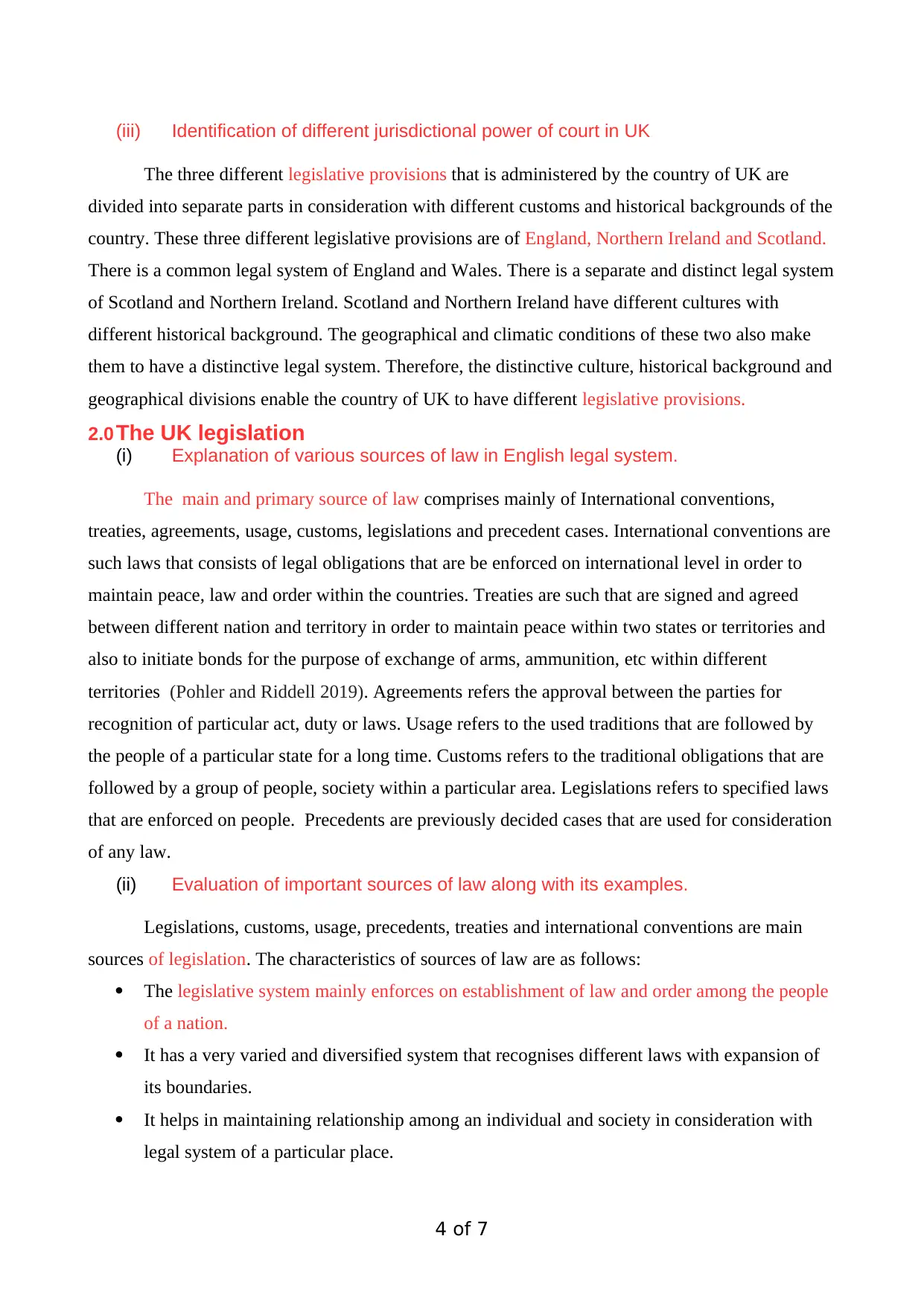
(iii) Identification of different jurisdictional power of court in UK
The three different legislative provisions that is administered by the country of UK are
divided into separate parts in consideration with different customs and historical backgrounds of the
country. These three different legislative provisions are of England, Northern Ireland and Scotland.
There is a common legal system of England and Wales. There is a separate and distinct legal system
of Scotland and Northern Ireland. Scotland and Northern Ireland have different cultures with
different historical background. The geographical and climatic conditions of these two also make
them to have a distinctive legal system. Therefore, the distinctive culture, historical background and
geographical divisions enable the country of UK to have different legislative provisions.
2.0 The UK legislation
(i) Explanation of various sources of law in English legal system.
The main and primary source of law comprises mainly of International conventions,
treaties, agreements, usage, customs, legislations and precedent cases. International conventions are
such laws that consists of legal obligations that are be enforced on international level in order to
maintain peace, law and order within the countries. Treaties are such that are signed and agreed
between different nation and territory in order to maintain peace within two states or territories and
also to initiate bonds for the purpose of exchange of arms, ammunition, etc within different
territories (Pohler and Riddell 2019). Agreements refers the approval between the parties for
recognition of particular act, duty or laws. Usage refers to the used traditions that are followed by
the people of a particular state for a long time. Customs refers to the traditional obligations that are
followed by a group of people, society within a particular area. Legislations refers to specified laws
that are enforced on people. Precedents are previously decided cases that are used for consideration
of any law.
(ii) Evaluation of important sources of law along with its examples.
Legislations, customs, usage, precedents, treaties and international conventions are main
sources of legislation. The characteristics of sources of law are as follows:
The legislative system mainly enforces on establishment of law and order among the people
of a nation.
It has a very varied and diversified system that recognises different laws with expansion of
its boundaries.
It helps in maintaining relationship among an individual and society in consideration with
legal system of a particular place.
4 of 7
The three different legislative provisions that is administered by the country of UK are
divided into separate parts in consideration with different customs and historical backgrounds of the
country. These three different legislative provisions are of England, Northern Ireland and Scotland.
There is a common legal system of England and Wales. There is a separate and distinct legal system
of Scotland and Northern Ireland. Scotland and Northern Ireland have different cultures with
different historical background. The geographical and climatic conditions of these two also make
them to have a distinctive legal system. Therefore, the distinctive culture, historical background and
geographical divisions enable the country of UK to have different legislative provisions.
2.0 The UK legislation
(i) Explanation of various sources of law in English legal system.
The main and primary source of law comprises mainly of International conventions,
treaties, agreements, usage, customs, legislations and precedent cases. International conventions are
such laws that consists of legal obligations that are be enforced on international level in order to
maintain peace, law and order within the countries. Treaties are such that are signed and agreed
between different nation and territory in order to maintain peace within two states or territories and
also to initiate bonds for the purpose of exchange of arms, ammunition, etc within different
territories (Pohler and Riddell 2019). Agreements refers the approval between the parties for
recognition of particular act, duty or laws. Usage refers to the used traditions that are followed by
the people of a particular state for a long time. Customs refers to the traditional obligations that are
followed by a group of people, society within a particular area. Legislations refers to specified laws
that are enforced on people. Precedents are previously decided cases that are used for consideration
of any law.
(ii) Evaluation of important sources of law along with its examples.
Legislations, customs, usage, precedents, treaties and international conventions are main
sources of legislation. The characteristics of sources of law are as follows:
The legislative system mainly enforces on establishment of law and order among the people
of a nation.
It has a very varied and diversified system that recognises different laws with expansion of
its boundaries.
It helps in maintaining relationship among an individual and society in consideration with
legal system of a particular place.
4 of 7
Paraphrase This Document
Need a fresh take? Get an instant paraphrase of this document with our AI Paraphraser
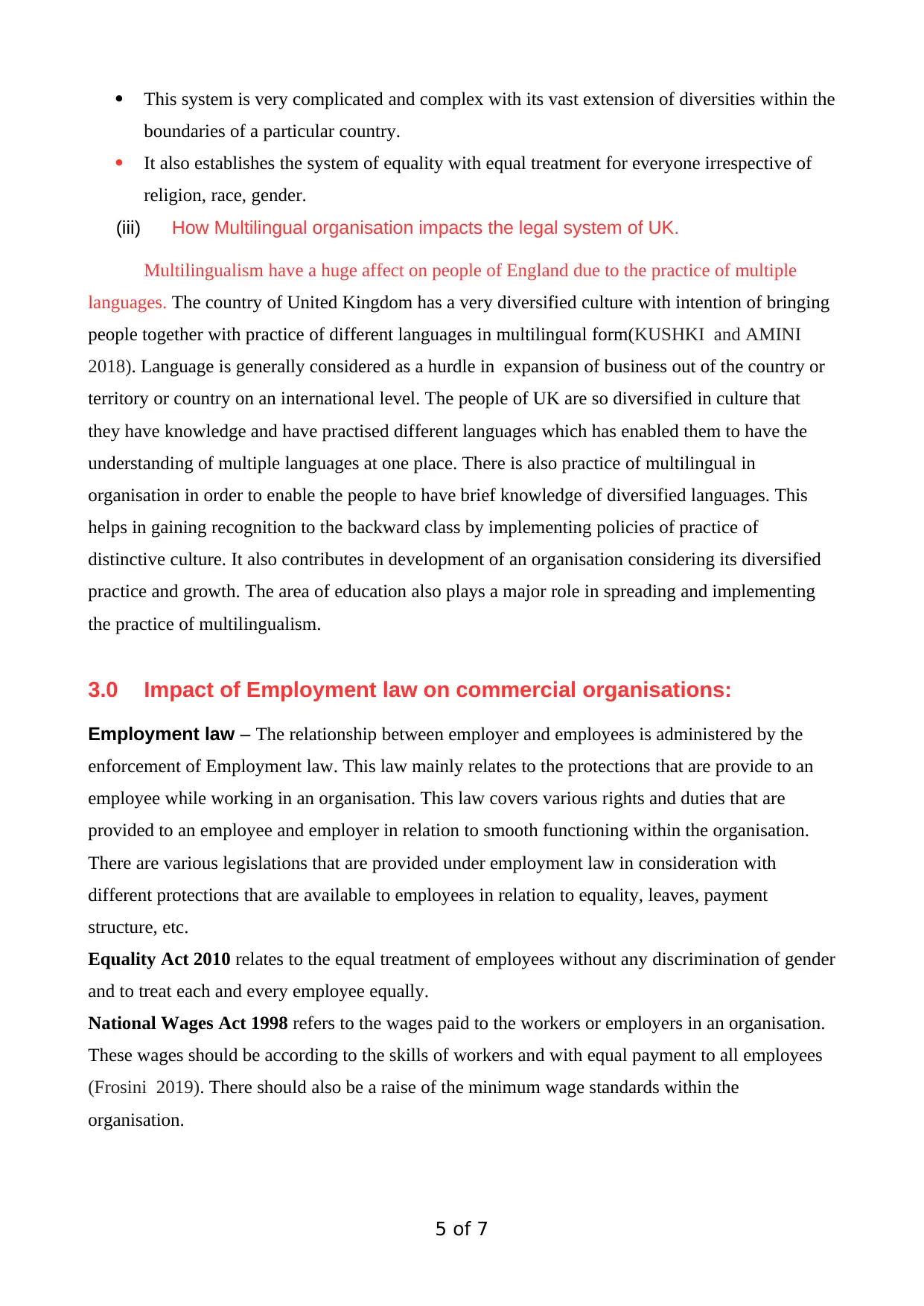
This system is very complicated and complex with its vast extension of diversities within the
boundaries of a particular country.
It also establishes the system of equality with equal treatment for everyone irrespective of
religion, race, gender.
(iii) How Multilingual organisation impacts the legal system of UK.
Multilingualism have a huge affect on people of England due to the practice of multiple
languages. The country of United Kingdom has a very diversified culture with intention of bringing
people together with practice of different languages in multilingual form(KUSHKI and AMINI
2018). Language is generally considered as a hurdle in expansion of business out of the country or
territory or country on an international level. The people of UK are so diversified in culture that
they have knowledge and have practised different languages which has enabled them to have the
understanding of multiple languages at one place. There is also practice of multilingual in
organisation in order to enable the people to have brief knowledge of diversified languages. This
helps in gaining recognition to the backward class by implementing policies of practice of
distinctive culture. It also contributes in development of an organisation considering its diversified
practice and growth. The area of education also plays a major role in spreading and implementing
the practice of multilingualism.
3.0 Impact of Employment law on commercial organisations:
Employment law – The relationship between employer and employees is administered by the
enforcement of Employment law. This law mainly relates to the protections that are provide to an
employee while working in an organisation. This law covers various rights and duties that are
provided to an employee and employer in relation to smooth functioning within the organisation.
There are various legislations that are provided under employment law in consideration with
different protections that are available to employees in relation to equality, leaves, payment
structure, etc.
Equality Act 2010 relates to the equal treatment of employees without any discrimination of gender
and to treat each and every employee equally.
National Wages Act 1998 refers to the wages paid to the workers or employers in an organisation.
These wages should be according to the skills of workers and with equal payment to all employees
(Frosini 2019). There should also be a raise of the minimum wage standards within the
organisation.
5 of 7
boundaries of a particular country.
It also establishes the system of equality with equal treatment for everyone irrespective of
religion, race, gender.
(iii) How Multilingual organisation impacts the legal system of UK.
Multilingualism have a huge affect on people of England due to the practice of multiple
languages. The country of United Kingdom has a very diversified culture with intention of bringing
people together with practice of different languages in multilingual form(KUSHKI and AMINI
2018). Language is generally considered as a hurdle in expansion of business out of the country or
territory or country on an international level. The people of UK are so diversified in culture that
they have knowledge and have practised different languages which has enabled them to have the
understanding of multiple languages at one place. There is also practice of multilingual in
organisation in order to enable the people to have brief knowledge of diversified languages. This
helps in gaining recognition to the backward class by implementing policies of practice of
distinctive culture. It also contributes in development of an organisation considering its diversified
practice and growth. The area of education also plays a major role in spreading and implementing
the practice of multilingualism.
3.0 Impact of Employment law on commercial organisations:
Employment law – The relationship between employer and employees is administered by the
enforcement of Employment law. This law mainly relates to the protections that are provide to an
employee while working in an organisation. This law covers various rights and duties that are
provided to an employee and employer in relation to smooth functioning within the organisation.
There are various legislations that are provided under employment law in consideration with
different protections that are available to employees in relation to equality, leaves, payment
structure, etc.
Equality Act 2010 relates to the equal treatment of employees without any discrimination of gender
and to treat each and every employee equally.
National Wages Act 1998 refers to the wages paid to the workers or employers in an organisation.
These wages should be according to the skills of workers and with equal payment to all employees
(Frosini 2019). There should also be a raise of the minimum wage standards within the
organisation.
5 of 7
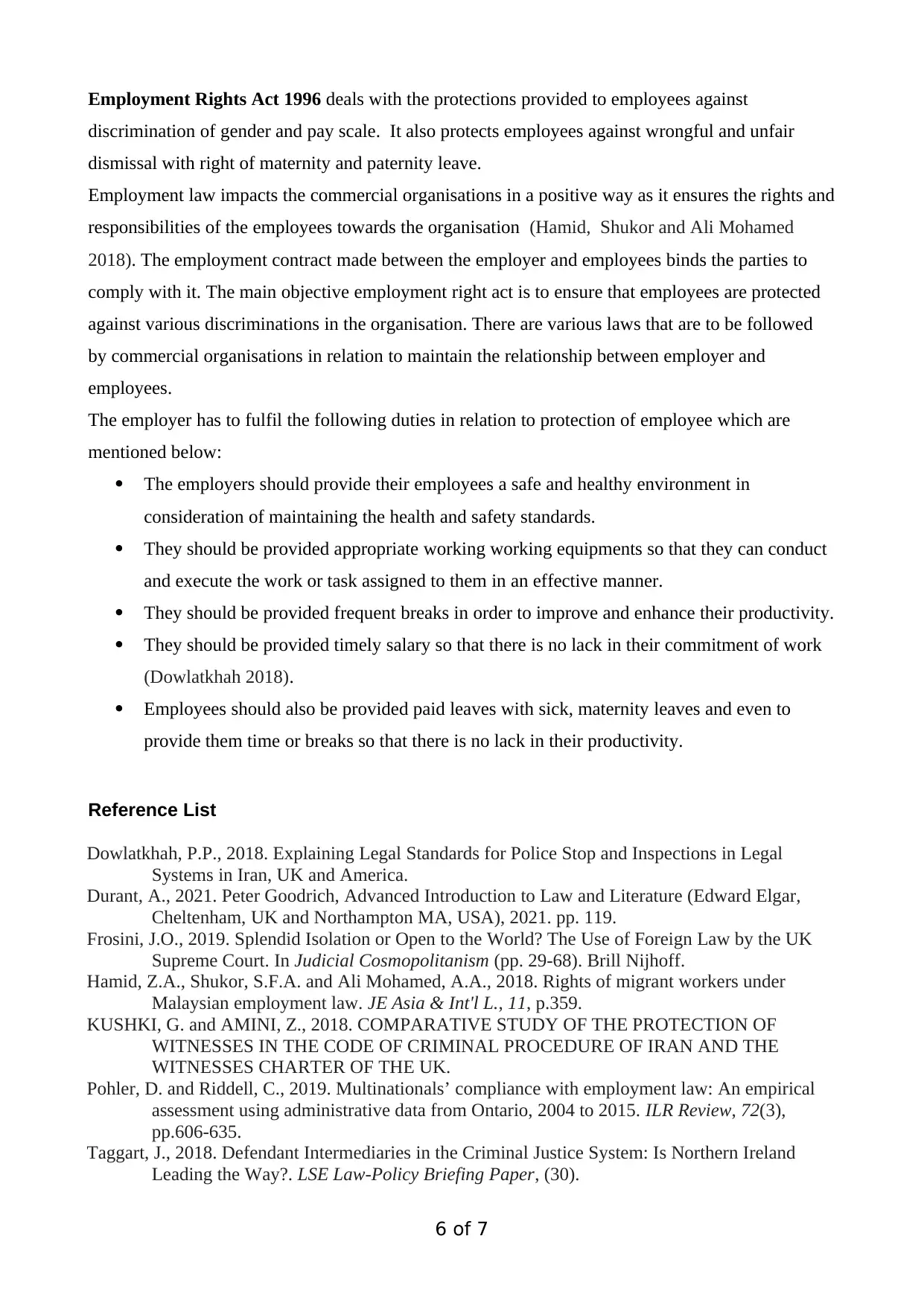
Employment Rights Act 1996 deals with the protections provided to employees against
discrimination of gender and pay scale. It also protects employees against wrongful and unfair
dismissal with right of maternity and paternity leave.
Employment law impacts the commercial organisations in a positive way as it ensures the rights and
responsibilities of the employees towards the organisation (Hamid, Shukor and Ali Mohamed
2018). The employment contract made between the employer and employees binds the parties to
comply with it. The main objective employment right act is to ensure that employees are protected
against various discriminations in the organisation. There are various laws that are to be followed
by commercial organisations in relation to maintain the relationship between employer and
employees.
The employer has to fulfil the following duties in relation to protection of employee which are
mentioned below:
The employers should provide their employees a safe and healthy environment in
consideration of maintaining the health and safety standards.
They should be provided appropriate working working equipments so that they can conduct
and execute the work or task assigned to them in an effective manner.
They should be provided frequent breaks in order to improve and enhance their productivity.
They should be provided timely salary so that there is no lack in their commitment of work
(Dowlatkhah 2018).
Employees should also be provided paid leaves with sick, maternity leaves and even to
provide them time or breaks so that there is no lack in their productivity.
Reference List
Dowlatkhah, P.P., 2018. Explaining Legal Standards for Police Stop and Inspections in Legal
Systems in Iran, UK and America.
Durant, A., 2021. Peter Goodrich, Advanced Introduction to Law and Literature (Edward Elgar,
Cheltenham, UK and Northampton MA, USA), 2021. pp. 119.
Frosini, J.O., 2019. Splendid Isolation or Open to the World? The Use of Foreign Law by the UK
Supreme Court. In Judicial Cosmopolitanism (pp. 29-68). Brill Nijhoff.
Hamid, Z.A., Shukor, S.F.A. and Ali Mohamed, A.A., 2018. Rights of migrant workers under
Malaysian employment law. JE Asia & Int'l L., 11, p.359.
KUSHKI, G. and AMINI, Z., 2018. COMPARATIVE STUDY OF THE PROTECTION OF
WITNESSES IN THE CODE OF CRIMINAL PROCEDURE OF IRAN AND THE
WITNESSES CHARTER OF THE UK.
Pohler, D. and Riddell, C., 2019. Multinationals’ compliance with employment law: An empirical
assessment using administrative data from Ontario, 2004 to 2015. ILR Review, 72(3),
pp.606-635.
Taggart, J., 2018. Defendant Intermediaries in the Criminal Justice System: Is Northern Ireland
Leading the Way?. LSE Law-Policy Briefing Paper, (30).
6 of 7
discrimination of gender and pay scale. It also protects employees against wrongful and unfair
dismissal with right of maternity and paternity leave.
Employment law impacts the commercial organisations in a positive way as it ensures the rights and
responsibilities of the employees towards the organisation (Hamid, Shukor and Ali Mohamed
2018). The employment contract made between the employer and employees binds the parties to
comply with it. The main objective employment right act is to ensure that employees are protected
against various discriminations in the organisation. There are various laws that are to be followed
by commercial organisations in relation to maintain the relationship between employer and
employees.
The employer has to fulfil the following duties in relation to protection of employee which are
mentioned below:
The employers should provide their employees a safe and healthy environment in
consideration of maintaining the health and safety standards.
They should be provided appropriate working working equipments so that they can conduct
and execute the work or task assigned to them in an effective manner.
They should be provided frequent breaks in order to improve and enhance their productivity.
They should be provided timely salary so that there is no lack in their commitment of work
(Dowlatkhah 2018).
Employees should also be provided paid leaves with sick, maternity leaves and even to
provide them time or breaks so that there is no lack in their productivity.
Reference List
Dowlatkhah, P.P., 2018. Explaining Legal Standards for Police Stop and Inspections in Legal
Systems in Iran, UK and America.
Durant, A., 2021. Peter Goodrich, Advanced Introduction to Law and Literature (Edward Elgar,
Cheltenham, UK and Northampton MA, USA), 2021. pp. 119.
Frosini, J.O., 2019. Splendid Isolation or Open to the World? The Use of Foreign Law by the UK
Supreme Court. In Judicial Cosmopolitanism (pp. 29-68). Brill Nijhoff.
Hamid, Z.A., Shukor, S.F.A. and Ali Mohamed, A.A., 2018. Rights of migrant workers under
Malaysian employment law. JE Asia & Int'l L., 11, p.359.
KUSHKI, G. and AMINI, Z., 2018. COMPARATIVE STUDY OF THE PROTECTION OF
WITNESSES IN THE CODE OF CRIMINAL PROCEDURE OF IRAN AND THE
WITNESSES CHARTER OF THE UK.
Pohler, D. and Riddell, C., 2019. Multinationals’ compliance with employment law: An empirical
assessment using administrative data from Ontario, 2004 to 2015. ILR Review, 72(3),
pp.606-635.
Taggart, J., 2018. Defendant Intermediaries in the Criminal Justice System: Is Northern Ireland
Leading the Way?. LSE Law-Policy Briefing Paper, (30).
6 of 7
⊘ This is a preview!⊘
Do you want full access?
Subscribe today to unlock all pages.

Trusted by 1+ million students worldwide

The End
7 of 7
7 of 7
1 out of 7
Related Documents
Your All-in-One AI-Powered Toolkit for Academic Success.
+13062052269
info@desklib.com
Available 24*7 on WhatsApp / Email
![[object Object]](/_next/static/media/star-bottom.7253800d.svg)
Unlock your academic potential
Copyright © 2020–2025 A2Z Services. All Rights Reserved. Developed and managed by ZUCOL.

